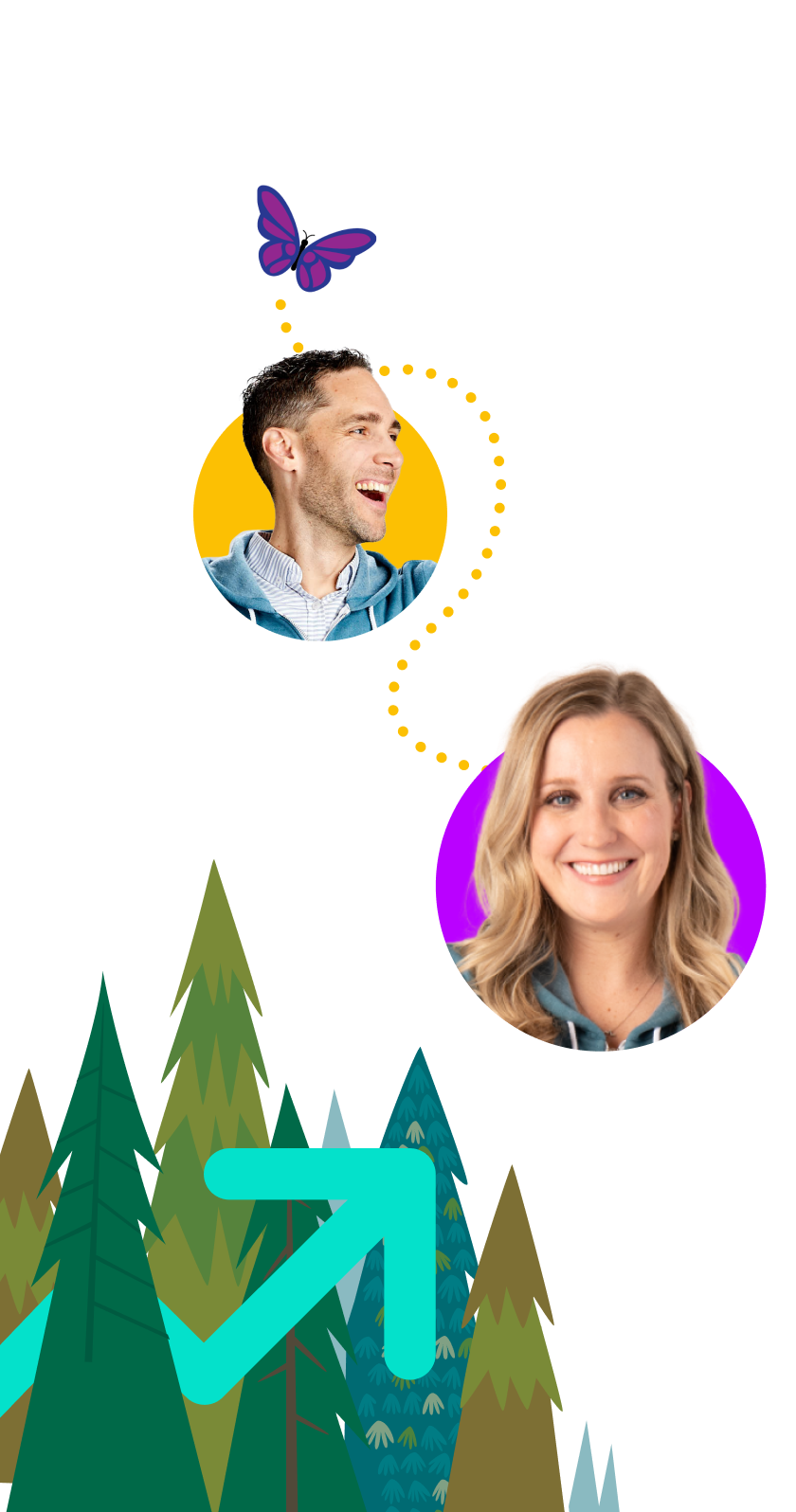We’ve come a long way since the ancient Greek chariot — the bicycle, the car, the segway? — but we’ve still never improved on the wheel. Some things are so great they don’t need to be reinvented. With all the change coming to sales today — the data, the automation, the AI — there’s some comfort in knowing that the most basic sales best practices are here to stay.
We’re sharing 18 of those sales best practices below, culled from the most successful sales professionals we know with decades of experience among them. This guidance ranges from joining a sales community to basing decisions on sales data, and we hope you’ll come back to it when you’re in need of a refresher on the fundamentals.
List of sales best practices:
Join the Salesblazer movement
We’re building the largest and most successful community of sales professionals, so you can learn, connect, and grow.
Despite all the teamwork, relationship-building, and human interaction, sales can feel like a lonely place. Our number one sales best practice is to plug into a network of sales pros to learn from the struggles and wins of others. A sales community is where you go to ask a pressing question you’re stuck on, share a new insight you just learned, and seek out new opportunities to grow your career.
Case in point: Salesblazer John Dao. He worked his way up from college dropout to top seller at IBM and Grubhub, in large part due to community. “I got to where I am because I had the support of my community at every step.” Dao said.
Connect with sellers like Dao on the new Salesblazer Community on Slack. It’s reimagining what community can do. Here’s what you’ll find:
- Networking in real-time. Join a virtual sales lounge where you can connect with like-minded sales pros in similar roles and expand who you know.
- Private role-based channels. Connect with fellow sales pros in your same role. There are channels for sales leaders, sales operations managers, account executives (AEs), and business development representatives (BDRs).
- Job postings. Find your next role, meet people who can refer you, and post opportunities you’re hiring for.
2. Build a buyer persona before you start selling
Don’t bark up the wrong tree. Create a buyer persona before you do anything else, listing out the traits of your ideal customer so you can be sure you’re focusing your attention on the right prospects.
Start by identifying ideal demographic traits like role and company, and psychological traits like motivations and challenges. Searching through job listings is one great way to discover this information. You can also send surveys to current customers with this role. Then, add this information to a single document and keep it on hand for easy reference, updating if your target customer changes. Ready to implement this sales best practice? Here’s a buyer persona guide to help you get started.
3. Try out your product as if you were an end user
You can’t sell what you don’t know. When you’re out there selling, remember to bring it back to the basics. What is your product? And what does it do?
To understand your product inside and out, test it out yourself to gain firsthand knowledge. Also, spend time each week asking your customers how they use the product in their day-to-day work. Finally, take advantage of your company’s product materials, from marketing to sales enablement. You’ll convey more authority with customers when you know both the strengths and weaknesses of your offering.
4. Use a CRM to bring customer data together
Customer relationship management software sets the foundation for growing your sales by bringing customer data together and automatically updating information as you sell. Ditch the spreadsheets and the post-it notes and consolidate sales data in one central place. You’ll gain a complete picture of prospects and customers. You’ll also have a clean and current dataset to fuel automation and AI.
“It would be a mistake to think a CRM just organizes data,” said Cherilynn Castleman, managing partner at the sales consultancy, CGI. “A CRM is actually about sales strategy. It provides rich data insights that help you anticipate buyer needs and tailor your approach, helping you close faster and more.”
5. Define the stages of your pipeline
Your deals will be more likely to waver and stall if you don’t have clearly defined stages that help you know when it’s time to move them forward. Bring structure to your pipeline that helps you quickly understand the status of each deal and what action is needed next.
To define this structure, start by identifying the stages in the sales process. Here are the traditional stages: qualify, discover, select, negotiate, close.
After you list the stages, write down the activities needed to advance deals to the next stage. These are your exit criteria for that stage. For example, the qualify stage might have the following activities: “Confirm the prospects fits the buyer persona, then set the first meeting.”
Get the free sales productivity workbook so you can take action on this sales best practice and put your pipeline stages down “on paper.”

Thanks, you’re subscribed!

6. Prioritize the leads that are likeliest to convert
These sales best practices are about working smarter, not harder. Make this the centerpiece of your sales efforts by focusing your attention on priority leads. These are leads that have demonstrated interest and need, making them easier sells. Focusing on them helps you shorten the sales cycle and increase win rates, which gets you to quota faster.
First, identify leads likeliest to close based on the strength of your relationship and whether the lead fits your target customer profile from your buyer persona. Second, prioritize these leads by potential deal size. This can be determined by identifying the products that are the best fits for the customer (and the ones they’ve shown interest in). Based on the answers to these questions, you should have a handful of high-value accounts to go after first.
7. Lead a great discovery call
After a prospect has shown interest in your company, it’s time to conduct a discovery call. The goal is to see if the customer is right for your product and to uncover pains and goals that will help you make the sale.
To prepare for a discovery call, come to the table with insights about their industry and business, and ideas of how you can help them achieve their goals. During the call, ask questions about their problems and aspirations. Read this guide to discovery calls to get the full list of what to ask. If the prospect is a fit for your product, end the discovery call with a clear next step — for example, by scheduling a follow-up meeting.
8. Identify key stakeholders to include in the deal
Large, complex deals will have many decision-makers involved. Ensure you have no obstacles to forward deal movement by identifying them early on, and be sure you’re sharing the right messages with the right people at the right times.
Here are some examples of decision-makers:
- Primary point of contact: They’re the prospect you initiate the deal with and continue to loop in at every step.
- The economic buyer: They lead in the buying process and do due diligence to ensure the vendor (that’s you) is providing value for their money.
- The champion: Someone with influence who can advocate for the sale on your behalf when you’re not there.
- The skeptic: The skeptic is the person who’s most likely to block the deal. “Ask your contact to point out the most skeptical person on the team when it comes to products like yours, and get to work on winning them over,” said sales expert Richard Harris, founder of The Harris Consulting Group. “Often, you won’t get to the decision-maker until you do.”
9. Build relationships based on trust
Eighty-seven percent of business buyers expect sales reps to act as trusted advisors. Create trust with two approaches.
First, show the customer that you have their best interests at heart. You can do this by listening intently, helping them without expecting anything in return, and empathizing with their challenges. Second, show the customer that you have the authority to help them find a solution to their problems. You can do this by bringing them original insights and painting a picture of how you’ll help them achieve their goals.
“Build trust; close the deal,” said Sunita Gill, a sales expert at Dale Carnegie. “Trust leads to loyalty, and loyal customers spread the word, keep buying over time, and spend more money when they do.”
10. Use AI to become more productive
High-performing sales teams are nearly twice as likely to use AI than low-performing teams. AI can help you identify the best step to take, generate content like emails, and assist you with tasks like updating customer data in the CRM. In other words, it can greatly increase productivity.
To get started with AI, begin by connecting customer data into a single source of truth, so AI models can understand it. Then, use it for a single use case to experience the results for yourself. When you’re happy with the outcome, expand to other use cases. One place to start is using generative AI for writing follow-up emails. Another: Using predictive AI to score your opportunities and rank them in order of their likelihood to close.
Discover 7 ways reps can use AI to speed up sales
See real-life examples of using AI to sell, from automating prospecting to writing emails and getting real-time guidance.


11. Share customer stories to show you can deliver
You probably don’t even buy shoes without reading several reviews. Your customers are the same way. They want to know that you can deliver because you’ve done it before. “Provide relevant customer stories and case studies to give customers the data they need to feel confident in the deal,” said Alexine Mudawar, CEO of Women in Sales.
She suggests sharing examples of how you’ve driven success for other customers, with storytelling about the before and after and numbers that prove the results. To uncover these stories, dedicate time every week to following up with existing customers to discuss their progress. Track metrics in partnership with them every month or quarter based on the outcomes you want to highlight. Depending on your product, these might include increases in time and cost savings, operational efficiency, and revenue growth.
12. Tailor your sales presentation to the prospect’s industry
A key trait of a great seller is empathy: the ability to step into the prospect’s shoes and imagine their challenges and dreams. This empathy needs to show when you deliver your sales presentation. Don’t just swap out logos on your corporate deck template. Go deeper, and customize your sales presentation to the individual needs of your customer.
For example, add new material that shows you have actively listened to your prospect’s needs. Show that you’ve done your research, and bring fresh new ideas for how you can help. This level of customization is part of a sales technique called solution selling, and it will help you stand out as an advisor, not just a salesperson.
Then, when presenting, stay tuned in to how your prospect is responding and leave room for questions and conversation. Keep checking in as you go to make sure the audience is still following along, step by step.
13. Mine past sales calls for insights to move the deal forward
Sales calls are a treasure trove of important information, such as concerns raised, questions asked, and commitments made. You can use these insights to help build trust and move the deal forward. Sales best practice: Explore past conversations to home in on the most common competitor mentions and objections to proactively address them moving forward. You should also review past calls every time you have a follow-up discussion so you can pick up the conversation where it last left off.
Exploring past sales calls, while critical, can be tedious and time-consuming.
Conversational intelligence technology can help by turning your sales conversations into a searchable record. This allows you to explore past conversations to quickly get up to speed. For example, if you need to prepare for a meeting in a hurry, you can go to the past call transcript and search for key moments by keyword — think competitor mentions, pricing objections, and features discussed.
14. Learn how to run an effective product demo
The product demo is where the rubber meets the road. You’ve worked hard to qualify the prospect, understand their pains, and create a pitch to advance the conversation. Now it’s time to show your prospect exactly what they’ll be getting.
“To create a product demo, choose a use case that will help you tell the story of how your product goes from challenge to solution,” said Stuart Blake, sales leader at TravelPerk. “Focus first on the outcomes you can achieve, then second on the features that help you achieve it.”
Finally, close the demo with expectations for what the customer will need in order to succeed, from their time commitment to technological requirements. This will help you ground the conversation for the final stages of the deal.
15. Lean on sales data to make better decisions
“Whether it’s customer response rates, leads in pipe, or quota attainment, there is always another metric to track,” said Kristen Page, an enterprise account director at Salesforce. The task at hand? “Learn how to pull in the right sales data and analyze it effectively.”
To get closer to the data, begin by identifying your most important sales metrics. This blog post has a list of the nine most important sales KPIs to track. Then, make sure you have a way to input, update, and access customer data in order to measure it.
Sales automation can help. Use automatic data capture to collect and sync customer and sales information from emails and calls. Then, put your data to work by using it as an input for sales AI models that can guide you with insights as you sell.
16. Overcome objections by addressing the concerns beneath them
Objections are a natural part of the sales process. When you handle them, you speed up the sales process and build trust so you can ease fears and concerns.
Prospects may raise objections around pricing, value, or decision-making authority. They may also share that they’re just not feeling the urgency to make a change.
Before you sell, familiarize yourself with the most common sales objections. When one of them comes up, empathize with their concern, ask them open-ended questions to get to the bottom of it, and change the topic to discuss value instead of pain. When you’ve found a point of agreement, transition to close.
17. Nurture relationships after the sale
Great reps know that the greatest opportunities come from existing customers; a 2024 study of small business owners revealed that repeat customers spend 67% more than new customers. Earlier, in the section on sharing customer stories (sales best practice #11), we recommended setting aside time during the week to meet with existing customers, support their success, and monitor their progress. These regular check-ins are also an opportunity to set the stage for upselling, which allows you to bring in more revenue by driving customers to purchase higher-value offerings.
When you’re focused on continually delivering value, the upsells flow naturally. In fact, upsells can lead to even bigger upsells and cross-sells, and fuel customer retention. For example, at Salesforce, we’ve found that customers are much more likely to stay with us long-term when they’ve purchased multiple offerings. So we make it a priority to deepen our customer relationships and sell more products to them when they’re ready.
18. Level up your game with sales training
Sales training is a great way to keep pace with all the dizzying change out there. There are training programs for everything from how to build an authentic connection to closing deals effectively.
“As a straight-shooter from Boston, I’m all about setting clear goals when it comes to choosing the best program for you — not chasing fads,” said John Barrows, sales expert at CEO of JB Sales. “Maybe you want to improve sales tactics, learn a new methodology, or gain a sales certification. Finding a program that will help you achieve these goals is key.” Get the definitive list of 22 top sales training programs.
Share your favorite sales best practices in the Salesblazer community
Sales success is all about bringing technology and the human connection together in the same frame. These sales best practices have come from the greatest sellers we know, and now we want to hear from another great seller — you!
Join the conversation on the new Salesblazer Community on Slack and share what you’ve learned. You never know who might need your insights.
Want to take the #1 CRM for a test drive?
Go on our Guided Tour to see how Sales Cloud boosts productivity at every stage of the sales cycle.









